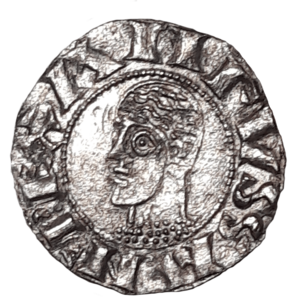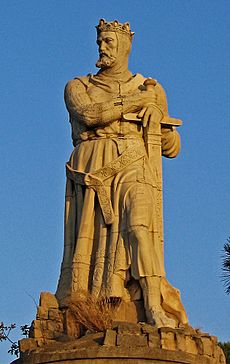Alfonso the Battler facts for kids
Quick facts for kids Alfonso I |
|
|---|---|

Alfonso's Aragonese coin
|
|
| King of Aragon and Navarre | |
| Reign | 28 September 1104 – 7 September 1134 |
| Predecessor | Peter I |
| Successor | Ramiro II of Aragon García Ramírez of Navarre |
| Emperor of All Spain (jure uxoris) | |
| Reign | 1109–7 September 1134 |
| Predecessor | Alfonso VI |
| Successor | Alfonso VII (as sole monarch) |
| Co-monarch | Urraca (1109–1126) and Alfonso VII (1126–1134) |
| Born | c. 1073/1074 |
| Died | 7 September 1134 (aged c. 60) Poleñino, Spain |
| Burial | Abbey of San Pedro el Viejo |
| Spouse | Urraca of León and Castile (annulled 1112) |
| House | House of Jiménez |
| Father | Sancho Ramírez |
| Mother | Felicie de Roucy |
| Religion | Roman Catholicism |
Alfonso I (born around 1073 or 1074, died September 7, 1134) was the King of Aragon and Navarre. He ruled from 1104 until his death in 1134. People called him the Battler or the Warrior because he was a very successful military leader.
Alfonso was the second son of King Sancho Ramírez. He became king after his brother, Peter I of Aragon, died. In 1109, he married Urraca of Castile, who was the queen of Castile, León, and Galicia. Because of this marriage, he started using the grand title "Emperor of Spain." This title was also used by his father-in-law, Alfonso VI.
Alfonso the Battler earned his nickname during the Reconquista. This was a long period when Christian kingdoms in Spain fought to take back land from Muslim rulers. He won many important battles in the middle Ebro region. He conquered Zaragoza in 1118. He also took control of cities like Ejea, Tudela, Calatayud, Borja, Tarazona, Daroca, and Monreal del Campo. He died in September 1134 after losing a battle against the Muslims at Fraga.
His nickname, "the Battler," comes from an old book called the Chronicle of San Juan de la Peña. It says that he was called this because "in Spain there wasn't as good a knight who won twenty-nine battles."
Contents
Early Life and Training
Alfonso spent his early years at the monastery of Siresa. There, he learned to read and write. He also practiced military skills under the guidance of Lope Garcés the Pilgrim. When Alfonso became king, he rewarded Lope Garcés with the county of Pedrola.
During his brother's rule, Alfonso helped capture Huesca in the Battle of Alcoraz in 1096. Huesca became the kingdom's largest city and new capital. He also joined El Cid's military trips to Valencia. His father gave him control over areas like Biel, Luna, Ardenes, and Bailo.
Alfonso became the next in line for the throne after a series of sad events. His brother's children, Isabella and Peter, both died in 1103 and 1104.
Marriage and Conflicts
Alfonso was a passionate warrior. He had fought many battles before he married Queen Urraca of León in 1109. He was over 30 years old and had not been married before. Urraca was a strong-willed queen who did not want to be second-in-command.
Her father, Alfonso VI of León, had arranged the marriage in 1106. The goal was to unite the two main Christian kingdoms against the Almoravids, a Muslim group. The marriage was also meant to provide a skilled military leader. However, Alfonso and Urraca often argued and even fought openly. In 1112, Alfonso even put Urraca under siege at Astorga.
Alfonso had the support of some nobles who benefited from the chaos. He was a much better soldier than his opponents. He won battles like the Battle of Candespina and the Battle of Viadangos. However, his main supporters were his Aragonese soldiers, and they were not enough to control Castile and León.
The Pope declared Alfonso and Urraca's marriage invalid in 1110 because they were second cousins. But Alfonso ignored this and stayed married to Urraca until 1114. During his marriage, he called himself "King and Emperor of Castile, Toledo, Aragón, Pamplona, Sobrarbe, and Ribagorza." He used the title "emperor" because he ruled over three kingdoms.
Some historians have suggested that Alfonso was not very interested in women. An old writer named Ibn al-Athir said that Alfonso was a tireless soldier who slept in his armor. When asked why he didn't enjoy time with women, Alfonso reportedly said that a man devoted to war needs the company of other men, not women.
Relations with the Church
Alfonso also had disagreements with the Church, especially with the Cistercian monks. He even sent Archbishop Bernard into exile. He replaced the abbot of Sahagún with his own brother.
Eventually, he had to give up his control in Castile and León to his stepson, Alfonso VII of Castile. Pope Calixtus II helped arrange an agreement between Alfonso and his stepson.
In 1122, Alfonso founded a group of knights in Belchite. Their purpose was to fight against the Almoravids. This was the beginning of military orders in Aragon. Later, he also organized a branch of the Militia Christi (Knights of Christ) at Monreal del Campo.
Military Victories
Alfonso spent his first four years as king constantly fighting the Muslims. In 1105, he conquered Ejea and Tauste. He also strengthened the defenses of Castellar and Juslibol. In 1106, he defeated Ahmad II al-Musta'in of Zaragoza. In 1107, he took Tamarite de Litera and San Esteban de Litera.
After a period focused on his marriage, he continued his conquests in 1117. He took Fitero, Corella, Cintruénigo, Murchante, Monteagudo, and Cascante.
In 1118, a special meeting called the Council of Toulouse called for a crusade to help conquer Zaragoza. Many French knights joined Alfonso. They captured Almudévar, Gurrea de Gállego, and Zuera. By the end of May, they were besieging Zaragoza itself. The city fell on December 18. Alfonso's forces took over the Azuda, which was the government tower. The city's great palace was given to the monks. Zaragoza quickly became Alfonso's new capital.
Two years later, in 1120, he defeated a Muslim army that tried to retake Zaragoza at the Battle of Cutanda. He allowed Muslims to continue living in the city, keep their property, and practice their religion. They just had to pay taxes and move to the suburbs.
In 1119, Alfonso recaptured many towns, including Cervera, Tarazona, and Daroca. He started to besiege Calatayud. However, he had to leave to defeat the army trying to retake Zaragoza. After Calatayud fell, he took more towns like Bubierca and Alhama de Aragón. In 1123, he besieged and captured Lleida, which was controlled by the count of Barcelona. From 1124 to 1125, he led a risky trip deep into Andalusia.
In a major raid in 1125, he brought many Christians from Granada back with him. From 1125 to 1126, he campaigned against Granada and Córdoba. In 1127, he reconquered Longares. However, he lost all his Castilian lands to Alfonso VII. He signed a peace treaty with Castile in 1128, which set the borders between their kingdoms.
He conquered Molina de Aragón and settled people in Monzón in 1129. He then besieged Valencia, which had been lost after El Cid's death.
In October 1130, he traveled north of the Pyrenees mountains to protect the Val d'Aran. In early 1131, he besieged Bayonne. People said he ruled "from Belorado to Pallars and from Bayonne to Monreal."
Alfonso's Will and Death
At the siege of Bayonne in October 1131, Alfonso made a will. He decided to leave his kingdom to three religious military orders based in Palestine: the Knights Templars, the Hospitallers, and the Knights of the Holy Sepulchre. These groups were largely independent.
Historians have found this will puzzling. It seemed like a very religious act that went against his life's work. Some historians believe it was a clever plan to prevent the Pope from interfering in who would rule next. It also aimed to stop Urraca's son, Alfonso VII of Castile, from taking over. Alfonso also left gifts to important churches in Castile. This might have encouraged church leaders there to support his will and limit Alfonso VII's plans. However, no church leaders witnessed the will in 1131.
In the end, his nobles refused to follow the will. Instead, they brought his brother Ramiro out of a monastery to become king. Some historians think Alfonso might have secretly intended this outcome.
His last military campaigns were against Mequinenza (1133) and Fraga (1134). At Fraga, García Ramírez of Navarre, who would become the future king of Navarre, fought alongside him. Fraga fell on July 17. Alfonso died by September of that year. His tomb is in the monastery of San Pedro in Huesca.
Who Ruled Next?
The nobles of Alfonso's kingdoms rejected his will. They looked for new rulers. Alfonso's only brother, Ramiro II of Aragon, had been a monk since he was a child. He was not seen as suitable to rule a kingdom that was always under military threat.
Alfonso's stepson, Alfonso VII of León, also wanted to be king. However, he did not get much support from the local nobles. The nobles of Navarre chose García Ramírez of Navarre to be their king. The Aragonese nobles chose Ramiro, Alfonso's brother. They took him from the monastery and made him king. They even arranged for him to marry Agnes, the sister of the Duke of Aquitaine. Then, they promised their newborn daughter to Ramon Berenguer IV, Count of Barcelona, making him Ramiro's heir.
This situation led to big changes in the kingdoms of Spain. Aragon and Navarre became separate kingdoms. Aragon and Catalonia united. Some historians also say it showed Castile's power in Spain.
The Impostor King
Later, during the rule of Alfonso II of Aragon, a man appeared claiming to be Alfonso the Battler. This happened decades after the real Alfonso I had died. Alfonso II wrote letters to the King of France about this man. The pretender was an old man, which matched the age the Battler would have been. Alfonso II wanted the French king to arrest him.
According to old records, the impostor was welcomed in cities like Zaragoza, Calatayud, and Daroca, which the Battler had conquered. But when people found out he was fake, he was executed in Barcelona in 1181. Some historians think that certain Aragonese lords might have supported this pretender at first.
Old stories about Alfonso the Battler's death varied. Some believed he died in battle, others that his body was never found. Some even thought he fled in shame and became a pilgrim. The story of the impostor was added to these legends over time.
Candidates for Succession
| Candidates to succeed Alfonso the Battler | |||||||||||||||||||||||||||||||||||||||||||||||||||||||||||||||||||||||||||||||||||||||||||||||||||||||||||||||||||||||||||||||||||||||||||||||||||||||||||||||||||||||||||||||||||||||||||||||||||||||||||||||||||||||||||||||||||||||||||||||||||||||||||||||||||||||||||||||||||||||||||||||||||||||||||||||||||||||||||||||||||||||||||||||||||||||||||||||||||||||||||||||||||||||||||||||||||||||||||||||||||||||||||||||||||||||||||||||||||||||||||||||||||||||||||||||||||||||||||||||||||||||||||||||||||||||||||||||||||||||||||||||||||||||||||||||||||||||||||||||||||||||||||||||||||||||||||||||||||||||||||||||||||||||||||||||||||||||||||||||||||||||||||||||||||||
|---|---|---|---|---|---|---|---|---|---|---|---|---|---|---|---|---|---|---|---|---|---|---|---|---|---|---|---|---|---|---|---|---|---|---|---|---|---|---|---|---|---|---|---|---|---|---|---|---|---|---|---|---|---|---|---|---|---|---|---|---|---|---|---|---|---|---|---|---|---|---|---|---|---|---|---|---|---|---|---|---|---|---|---|---|---|---|---|---|---|---|---|---|---|---|---|---|---|---|---|---|---|---|---|---|---|---|---|---|---|---|---|---|---|---|---|---|---|---|---|---|---|---|---|---|---|---|---|---|---|---|---|---|---|---|---|---|---|---|---|---|---|---|---|---|---|---|---|---|---|---|---|---|---|---|---|---|---|---|---|---|---|---|---|---|---|---|---|---|---|---|---|---|---|---|---|---|---|---|---|---|---|---|---|---|---|---|---|---|---|---|---|---|---|---|---|---|---|---|---|---|---|---|---|---|---|---|---|---|---|---|---|---|---|---|---|---|---|---|---|---|---|---|---|---|---|---|---|---|---|---|---|---|---|---|---|---|---|---|---|---|---|---|---|---|---|---|---|---|---|---|---|---|---|---|---|---|---|---|---|---|---|---|---|---|---|---|---|---|---|---|---|---|---|---|---|---|---|---|---|---|---|---|---|---|---|---|---|---|---|---|---|---|---|---|---|---|---|---|---|---|---|---|---|---|---|---|---|---|---|---|---|---|---|---|---|---|---|---|---|---|---|---|---|---|---|---|---|---|---|---|---|---|---|---|---|---|---|---|---|---|---|---|---|---|---|---|---|---|---|---|---|---|---|---|---|---|---|---|---|---|---|---|---|---|---|---|---|---|---|---|---|---|---|---|---|---|---|---|---|---|---|---|---|---|---|---|---|---|---|---|---|---|---|---|---|---|---|---|---|---|---|---|---|---|---|---|---|---|---|---|---|---|---|---|---|---|---|---|---|---|---|---|---|---|---|---|---|---|---|---|---|---|---|---|---|---|---|---|---|---|---|---|---|---|---|---|---|---|---|---|---|---|---|---|---|---|---|---|---|---|---|---|---|---|---|---|---|---|---|---|---|---|---|---|---|---|---|---|---|---|---|---|---|---|---|---|---|---|---|---|---|---|---|---|---|---|---|---|---|---|---|---|---|---|---|---|---|---|---|---|---|---|---|---|---|---|---|---|---|---|---|---|---|---|---|---|---|---|---|---|---|---|---|---|---|---|---|---|---|---|---|---|---|---|---|---|---|---|---|---|---|---|---|---|---|---|---|---|---|---|---|---|---|---|---|---|---|---|---|---|---|---|---|---|---|---|---|---|---|---|---|---|---|---|---|---|---|---|---|---|---|---|---|---|---|---|---|---|---|---|---|---|---|---|---|---|---|---|---|---|---|---|---|---|---|---|---|---|---|---|---|---|---|---|---|---|---|---|---|---|---|---|---|---|---|---|---|---|---|---|---|---|---|---|---|---|---|---|---|---|---|---|---|---|---|---|---|---|---|---|---|
|
|||||||||||||||||||||||||||||||||||||||||||||||||||||||||||||||||||||||||||||||||||||||||||||||||||||||||||||||||||||||||||||||||||||||||||||||||||||||||||||||||||||||||||||||||||||||||||||||||||||||||||||||||||||||||||||||||||||||||||||||||||||||||||||||||||||||||||||||||||||||||||||||||||||||||||||||||||||||||||||||||||||||||||||||||||||||||||||||||||||||||||||||||||||||||||||||||||||||||||||||||||||||||||||||||||||||||||||||||||||||||||||||||||||||||||||||||||||||||||||||||||||||||||||||||||||||||||||||||||||||||||||||||||||||||||||||||||||||||||||||||||||||||||||||||||||||||||||||||||||||||||||||||||||||||||||||||||||||||||||||||||||||||||||||||||||
| Regnal titles | ||
|---|---|---|
| Preceded by Peter I |
King of Aragon 1104–1134 |
Succeeded by Ramiro II |
| King of Navarre 1104–1134 |
Succeeded by García Ramírez |
|
| Preceded by Alfonso VI of León and Castile |
Emperor of All Spain 1109–1134 with Urraca of León (1109–1126) Alfonso VII (1126–1134) |
Succeeded by Alfonso VII of León and Castile |
See also
 In Spanish: Alfonso I de Aragón para niños
In Spanish: Alfonso I de Aragón para niños


